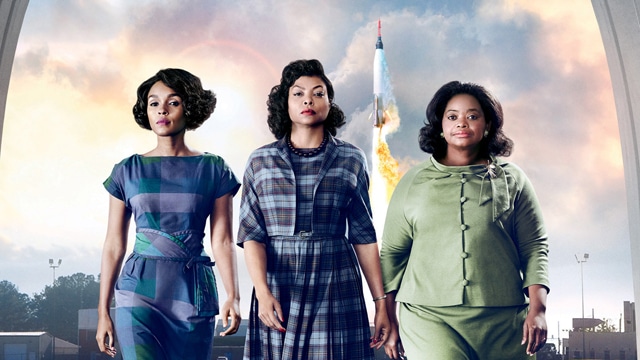Katherine Johnson is the smartest mathematician working for NASA, which desperately needs her skills as it tries to catch the Soviets in the Space Race. There’s only one problem: Johnson is a black woman working at a government laboratory in the segregated state of Virginia.
There are “colored” lunch rooms, water fountains and coffee pots. And even though she is the only one who can solve complex aeronautical formulas that are necessary to send a man safely into space, she still has to use the “colored” restroom, which is located out the front doors and in a separate building.
Hidden Figures (PG) expands to more than 2,400 theaters this weekend, telling the incredible true story of Johnson (Taraji P. Henson) and two other black women who played critical but under-the-radar roles in helping the United States win the Space Race. Johnson, particularly, had a major hand in calculating the right trajectory for John Glenn’s historical orbital flight—and she did it without computers.
The film also tells the stories of Dorothy Vaughan (Octavia Spencer), who was a computer technician and became NASA’s first African-American supervisor, and Mary Jackson (Janelle Monáe), who was NASA’s first black female aeronautical engineer. All of them worked at Langley Memorial Aeronautical Laboratory.
Hidden Figures opened in 25 theaters just after Christmas to qualify the film for the upcoming awards. After seeing it, I can say it’s truly Oscar-worthy. It is one of the most uplifting (and funny) films I have ever watched and—if it is included in last year’s lineup—one of the top films of 2016.
But is it family-friendly? And will kids even enjoy it? Let’s take a look …
The Good
Hidden Figures is a microcosm of everything that we want to remember and forget about the 1960s. The heroics of Alan Shepard and John Glenn inspired millions of children and adults, and Hidden Figures recaptures the same emotions many people had when they watched it live on TV (or when the rest of us watched the 1983 film The Right Stuff). Of course, the 1960s also were known for racism and segregation, and Hidden Figures puts that on display, too, while staying in PG-friendly territory. We see the ugly side of racism, but without hearing the n-word and without seeing much violence. (People gather around a television to watch a report about violence in the South.)
The determination, spunk and self-control of the three women is amazing. When a superior tells a re-assigned Katherine, “We’ve never had a colored in here …. don’t embarrass me,” Katherine responds not with words of hate but with a resolve to work hard, long hours and prove everyone wrong. When Mary discovers she must take classes at a whites-only college to become an engineer—even though it previously wasn’t required—she takes the matter to court and wins. Essentially, Hidden Figures is a loud endorsement of Martin Luther King Jr.’s nonviolence strategy and of the Apostle Paul’s words in Romans 1:21 (“overcome evil with good.”).
Despite the segregated setting, the movie isn’t a whites-versus-blacks film. Katherine’s white boss, Al Harrison (Kevin Costner), becomes one of her biggest champions and eventually chops down the “colored” bathroom sign, telling the ladies to use whichever restroom they wish. (“Here at NASA, we all pee the same color,” he says.)
Glenn goes out of his way to greet the women and then, prior to his flight, he requests that Katherine double-check the trajectory data. In fact, many of the white employees—including those who work alongside Mary—cheer for the women to succeed.
Hidden Figures includes a decent amount of spiritual content. Mary excitedly exclaims “Thank-you Jesus! Thank-you Jesus!” when she receives an assignment she wants. We see the three women in a church service, singing and then listening to the pastor’s sermon. Later, Katherine and her family eat a meal at home and a prayer is said “in Jesus’ name.”
The family unit is upheld, and there is no sexuality—explicit or implicit. Mary’s husband, who opposed her engineering ambitions at the beginning of the film, comes around in the end and supports her. Katherine and a boyfriend get engaged but don’t sleep together before marriage.
Finally, it is impossible to watch Hidden Figures as a Christian and not marvel at God’s creation. Glenn looks at Earth and exclaims “that view is tremendous!”—a reminder of David’s words in Psalm 19 (“the heavens declare the glory of God”).
The Bad
Hidden Figures contains no sexuality (there are two brief kissing scenes and a dancing scene) and no violence. The primary negative is the language, with about 20 words sprinkled throughout. (13 d—, 5 he–, 1 ba—-d, and one misuse of JC). During one scene at home, the three women also drink alcohol (it looks like moonshine in a Mason jar) and get drunk.
The Verdict: Family-Friendly?
My guess is that young children will get bored in this one, even if parents aren’t bothered by the few content problems. But for older children? That will depend on the comfort level of families with coarse language and the subject of racism. If not for the few content concerns, this one would be an educational and entertaining must-see for the entire family.
Discussion Questions
Why did most of Katherine’s co-workers despise her? Why didn’t Katherine and her friends react with anger? What qualities did you admire most in Katherine, Dorothy and Mary? How would the story have been different had they reacted with anger? What did they do to “win”? Why did Katherine’s boss, Mr. Harrison, support her? What was more significant in the story – racism or sexism? Does racism still exist today? If so, in what ways? What is the root of racism? What is the cure?
Entertainment rating: 4.5 out of 5. Family-friendly rating: 3.5 out of 5.
Hidden Figures is rated PG for thematic elements and some language.














